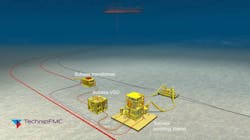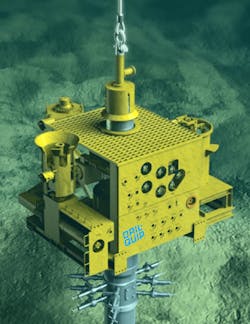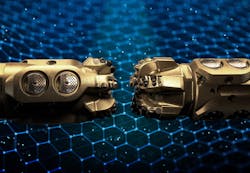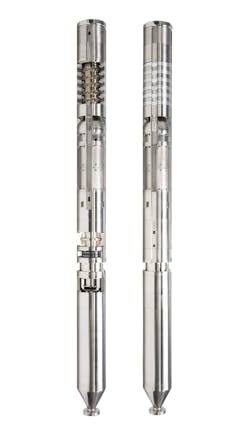While the COVID-19 pandemic forced the cancellation of the annual event in Houston, the Offshore Technology Conference (OTC) still honored new products and services in the market. Eighteen technologies from 14 companies from around the world received the Spotlight on New Technology Award. Five of the 14 companies also won the Spotlight on Small Business Award, which honors firms with less than 300 employees. Cindy Yeilding, chairperson, OTC Board of Directors, said: “Their new technologies and services are shaping the way offshore products and services are advancing into the future.”
TechnipFMC earned the award for its subsea power distribution station. This is said to simplify field installation, step-out wells and field expansions, supporting maximized reservoir recovery. The company claims the station can cut subsea boosting costs for brownfield projects up to 60% by eliminating the need for topsides expansion modules. It comprises a subsea transformer, subsea variable speed drive, (VSD) and power transmission umbilical and connectors.
The compact, configurable design is said to be scalable for a wide range of boosting and processing applications, and can operate in water depths up to 3,000 m (9,842 ft). Both the subsea transformer and VSD modules are based on proven topsides products from Brazilian electrical machines/technology specialist WEG.
Dril-Quip was recognized for its VXTe vertical subsea tree system, which is designed to eliminate the need for a tubing head spool and for orientations of the tubing hanger. Other features include a self-orienting stab sub, automatic space out of the tubing hanger, and an isolated annulus flow with the annulus gate valve packaged inside the tubing hanger. According to the company, this allows operators to run tubing hangers in a similar fashion to casing hangers, but without the need for time-consuming orientation.
Blake DeBerry, Dril-Quip’s CEO, added that the VXTe eliminates lead-impression measurement trips, while at the same time giving the option of running the tubing hanger and completing the well during the drilling phase.
“These benefits can eliminate a blowout preventer installation and removal sequence, which is currently a costly step while drilling an offshore well,” he said. “By streamlining the installation process and avoiding the cost of the tubing head spool and associated parts, the VXTe system can significantly reduce overall project development costs.”
Kuopio, Finland-based Rocsole received the recognition for its patented Liquid In-Tank Inspection (LITI) development. Previously, the offshore market had not applied tomographic imaging to any great extent for scanning vessels for water, oil, emulsion, or gas layers. The company says with the LTI, it is possible to provide full profiles of vessels with no radiation, which brings advantages in terms of safety and the environment. The system is also said to deliver reliable data on tanks and separators even in harsh or challenging conditions, assisting production optimization.
“The LITI Tank Profiler works just as well as any nucleonic devices, but without the typical cost and risks associated with the use of nucleonic devices,” said Arto Voutilainen, the company’s chief technology officer. “In addition, we provide continuous real-time data meaning that we can provide AI-powered predictive analytics for these sub-processes with our capabilities.”
Rocsole also won the Small Business Award.
Schlumberger earned two awards. The first was for the NeoSteer at-bit steerable system (ABSS). This directional drilling innovation integrates the cutting structure with the steering system. The system is said to be capable of drilling both high dogleg severity (DLS) curve sections and straighter higher-quality lateral sections at high performance in a single run.
The second award was for the Ora intelligent wireline formation testing platform, which integrates new downhole digital hardware and cloud-native software. Rated to 200°C (392°F) and 35,000 psi with dual-flowline architecture and featuring smart downhole automation, the platform represents a new benchmark in wireline formation testing capability, the company claims. It performs reliably and effectively in all conditions, including tight or unconsolidated formations and challenging fluids.
WFS Technologies won two spotlight awards and the Small Business Award.
Its first award was for the Seatooth SmartClamp, a smart, wireless structural monitoring system (SMS) for use on subsea structures. It incorporates the Seatooth wireless data processing and transmission platform offering short, medium and long-range hybrid communication options. As a result, the tool includes strain, vibration, pressure, and temperature monitoring.
The second award was for the Subsea Cloud Computing Network (SCCN). This is enabled by integrating with a SCM to create a subsea Wi-Fi hotspot. Seatooth smart devices, with edge computing and low power management systems can wirelessly connect directly to the network or cross-pollinate data using AUVs or ROVs for data harvesting. The company says the SCCN reduces both operating and asset integrity management costs as well as capex and risk while also extending a field’s operating life and reducing its carbon footprint.
Baker Hughes received two awards. The first was for the SureCONNECT intelligent wet-mate system. It enables connection and re-connection of upper completion components to the lower completion with hydraulic, electric, and/or fiber-optic lines. Operators can now achieve real-time, intervention less monitoring and control across the wellbore, enabling data-driven decisions to optimize performance and proactively mitigate risks, the company claims.
The second was for the Aptara lightweight compact tree. According to the company, the tree is 50% less weight and has the potential to reduce TOTEX (capex + opex) by more than 50%.
North Vancouver-based DarkVision Technologies Inc. received recognition for its HADES-F technology. It uses a high-resolution acoustic imaging head mounted on an articulating remotely-controlled robotic arm. The tool provides sub-millimetric measurements, images, and 3D reconstructions of any wellbore obstruction, wellhead, fish, or connection. This is sent to surface in real-time from any orientation, regardless of fluid clarity. The company also won the Small Business Award.
NOV won two awards. The first was for the SWIT, a sulfate removal and low salinity plant. It is designed for long-term continuous operation at the seabed for IOR and EOR purposes. By using unique, proprietary technology in combination with process simplifications in this configuration, the system can operate for more than 30-months maintenance free, the company claims.
The second was for the PowerBlade energy recovery system. It receives, stores, and provides regenerated energy based on operation, e.g. it regenerates energy from heave compensation. Further, it reduces power peaks “felt” by the generators and possible power bottlenecks, thereby reducing fuel consumption, improving the environmental footprint, and boosting equipment performance, the company claims.
The Netherlands-based Rolloos was recognized for its Red Zone Monitoring service. People on a drill floor are exposed to the risk of being in the line of fire or getting caught in between machines. The service keeps people safe and optimizes performance by combining advanced computer vision, AI, human-machine integration and classical change management. The company also won the Small Business Award.
Bosch Rexroth won the award for its high force and low voltage Subsea Valve Actuator (SVA). The compact electro-mechanical actuator with hydrostatic drive is said to provide up to SIL3 safety including condition monitoring, consume up to 75% less energy, and is designed for 25 years of operation. With redundant pressure compensation, it can reliably operate in the harsh environment of subsea applications. It can provide high forces to actuate the installed valves by using the available low voltage power supply - according to the Subsea Instrumentation Interface Standard.
Siemens was honored for the Siemens AM Monitor. The system uses machine learning algorithms to impartially evaluate the recoating during the printing of a 3D-printed component, with a speed and accuracy that cannot be matched by humans, the company claims.
Halliburton earned the award for the Xaminer Magnetic Resonance service. It is said to be the world’s first ultra-high pressure, 35,000-psi-rated magnetic resonance sensor for wireline.
Upwing Energy won the award for its Subsurface Compressor System (SCS). This system is the only downhole turbomachinery that can maximize gas and condensate production, recoverable reserves, gas-in-place recovery efficiency, and liquid unloading at the same time, the company claims. All these benefits can be realized in any type of formation and wellbore geometry in both onshore and offshore environments.
The system increases gas production and recoverable reserves by decreasing bottomhole flowing pressure and causing higher reservoir drawdown. It also carries liquids to the surface by creating higher gas velocities throughout the vertical and horizontal wellbores and prevents vapor condensation by increasing the temperature of the gas when exiting the compressor.
The subsurface compressor consists of two main components - a high-speed hermetically sealed permanent magnet motor with magnetic bearings and a hybrid wet gas compressor. These two components are coupled by a magnetic coupling that conveys torque from the hermetically sealed motor to the compressor with no mechanical shaft or seals.
The company also received the Small Business Award.
Advisian Digital earned the award for CAROL, a catalyst unloading robot for offshore, LNG, gas plant and refinery vessels. The system replaces the requirement to have a human inside the vessel during catalyst vacuuming operations. According to the company, human safety is improved by a factor of 10, and efficiency is improved by at least 20%.
OTC 2021 is scheduled for May 3-6.
About the Author
Jessica Stump
Editor
Jessica Stump is editor of Offshore Magazine. She uploads and writes news to the website, assembles surveys and electronic newsletters, and writes and edits articles for the magazine. She was the summer editorial intern at Offshore in 2009 and 2010 before joining full time in April 2011. She has a journalism degree from Texas Tech University.





